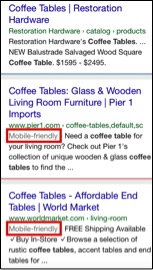By now you’ve most likely heard of Google’s latest SEO algorithm update, aptly nicknamed Mobilegeddon by the SEM industry. Website mobile-friendliness will now be a ranking signal within the organic results. This update shouldn’t come as a surprise as Google has been putting more emphasis on mobile over the last few years. The fascinating part is what this update means for the paid search industry.
Before delving into analysis, it’s important to understand what constitutes the mobile friendly algorithm and what is impacted. Jennifer Slegg of TheSEMPost wrote a great article that details everything you need to know about the algorithm. Along with mobile-friendliness now being a ranking factor, Google tells searchers if the page showcased in the listing is optimized for mobile. In the example below, Pier 1 and World Market have mobile pages while Restoration Hardware does not.

This update most impacts those websites that don’t have mobile versions. Whereas in the past it was highly recommended that sites be mobile optimized, it wasn’t a requirement for better rankings. Those non-mobile sites seeing significant traffic from organic could potentially be negatively impacted along the same lines of Panda and Penguin.
So what does this SEO update have to with paid search? More than you think.
Reliance On Paid Search
When Panda and Penguin first hit (and with the ongoing iterations), many companies were forced to invest a greater amount of their budgets into paid search. The loss of revenue from organic traffic needed to be made up somewhere and paid search helped to fill that void. In conjunction with stricter organic requirements, paid search ads began occupying a larger amount of the search real estate above the fold. This real estate was occupied by:
- Google Shopping ads
- More ad extensions
- More pronounced ads (ie: longer headlines and URLs showing in headlines)
Even websites that weren’t impacted by the SEO updates were at a loss due to Google’s increased emphasis on paid search.
Another significant development on the paid side was AdWords Enhanced Campaigns. In the 2013 rollout, mobile, tablet, and desktop targeting were rolled into individual campaigns. No longer was it necessary (or applicable) to create mobile, tablet, and desktop specific campaigns. Google allowed for mobile bid optimizers as well as mobile specific ads.

Again, though it wasn’t a requirement to run ads on mobile devices, advertisers could see that Google was making a strong push for smartphone advertising.
Where We Stand Today
With mobile-friendliness now a factor in the organic rankings, paid search won’t be far behind. In fact, TheSEMPost noticed mobile-friendly tags appearing on AdWords ads. Similarly to how Google tweaked its Ad Rank formula to include ad extensions, mobile-friendliness will almost certainly enter the equation in the near future.
From a holistic perspective, it’s clear that companies need to prioritize mobile much more than they do now. Going beyond SEO and paid search implications, mobile user experience needs to be part of the redesign and user interface process. The web and its associated properties are always evolving and those who fail to adapt will suffer the consequences. If your clients don’t have mobile sites, or the mobile versions are lacking, emphasize the importance of the SEO update. As history has taught us, these updates very rarely only impact one area. It isn’t a question of “if” as mobile guidelines will continue to be put into place for paid search.



